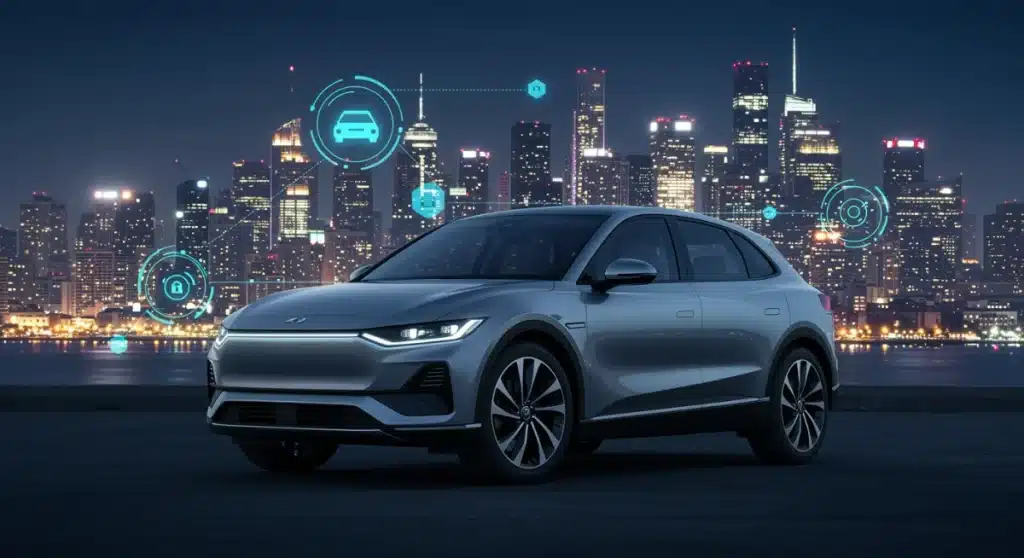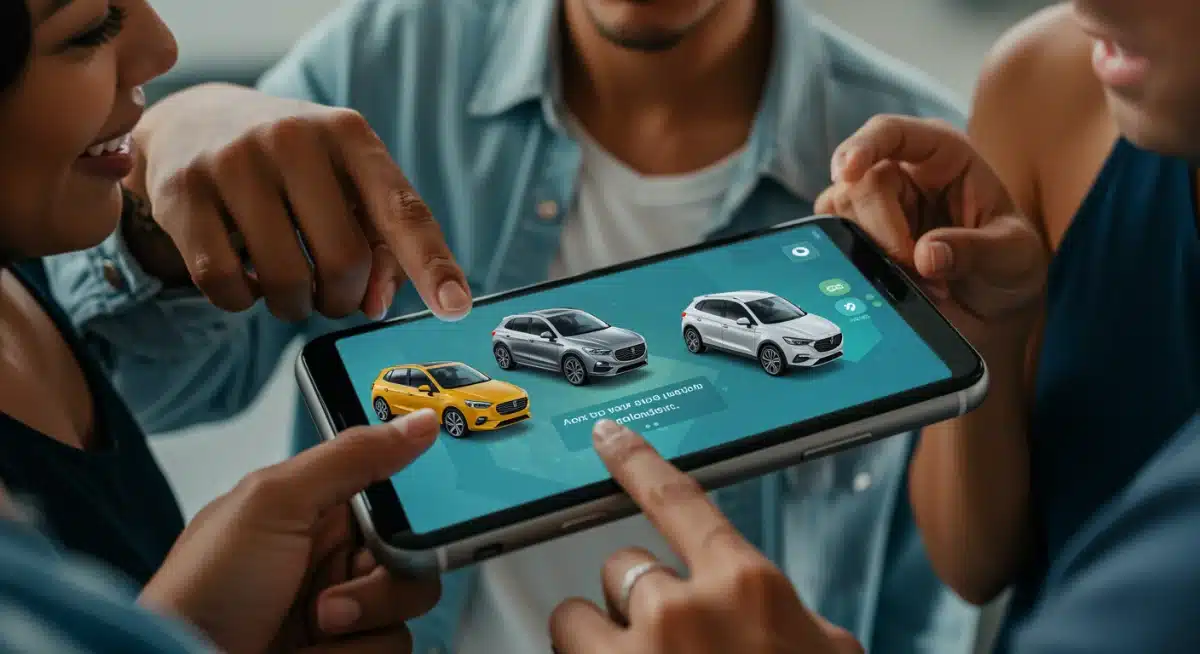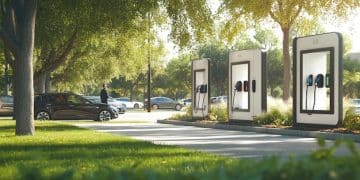Subscription Models: US Automakers Redefine Car Ownership by 2025

Major U.S. automakers are rapidly adopting subscription models, fundamentally changing how consumers interact with and access vehicles, moving beyond traditional ownership by 2025.
The automotive industry is on the cusp of a profound transformation, with the rise of subscription models poised to redefine car ownership as we know it. By 2025, major U.S. automakers are not just selling vehicles; they are offering flexible, service-oriented solutions that challenge the conventional paradigm of individual car possession. This shift reflects a broader trend towards mobility as a service, driven by evolving consumer preferences, technological advancements, and a desire for greater flexibility and cost predictability.
The evolving landscape of car ownership
For decades, car ownership in the United States has been synonymous with freedom and personal independence. The traditional model involved purchasing a vehicle outright or through a long-term loan, followed by years of maintenance, insurance, and eventual resale. However, this established framework is now facing unprecedented disruption from new mobility solutions.
Consumers, particularly younger generations, are increasingly prioritizing access over ownership. The financial burdens associated with buying a car—down payments, monthly loan installments, depreciation, and unexpected repairs—are significant deterrents. Subscription models offer an attractive alternative, bundling these costs into a single, predictable monthly fee, thereby simplifying the automotive experience.
Shifting consumer priorities
Modern consumers seek convenience, flexibility, and a personalized experience. They are accustomed to subscription services for everything from entertainment to groceries, and this expectation is now extending to transportation. The idea of having a vehicle that adapts to changing life stages or specific needs, without the long-term commitment, resonates deeply with this demographic.
- Flexibility: The ability to swap vehicles based on need (e.g., an SUV for a family trip, a sedan for daily commutes).
- Predictable costs: A single monthly payment covering insurance, maintenance, and sometimes even fuel or charging.
- Reduced hassle: No need to worry about depreciation, resale, or unexpected repair bills.
- Access to new technology: Subscribers often get access to the latest models and features without a full purchase.
This fundamental shift in consumer behavior is forcing automakers to rethink their business models, moving away from purely transactional relationships to more service-oriented engagements. The focus is shifting from selling units to providing comprehensive mobility solutions that cater to diverse lifestyles.
The evolving landscape of car ownership is not merely a fleeting trend; it represents a significant structural change in the automotive industry. Automakers are recognizing that embracing these new models is crucial for remaining competitive and relevant in a rapidly changing market. This proactive adaptation is essential for securing future revenue streams and customer loyalty.
Ford’s strategic pivot to subscription services
Ford, a titan of American manufacturing, is actively exploring and implementing subscription-based services to complement its traditional sales model. Recognizing the changing tides, Ford aims to offer customers more flexible access to its diverse vehicle lineup, from rugged trucks to efficient sedans and emerging electric vehicles.
The company’s approach involves leveraging its extensive dealer network to facilitate these services, ensuring a broad reach and seamless customer experience. Ford understands that while outright ownership will remain a core option, an increasing segment of the population desires alternatives that align with modern lifestyles and financial considerations.
FordPass and connected services
Ford has been at the forefront of integrating connected services into its vehicles through platforms like FordPass. This ecosystem allows for remote vehicle control, health alerts, and even in-car Wi-Fi. The natural progression is to bundle these digital offerings into subscription packages, enhancing the value proposition beyond the physical vehicle.
- FordPass Connect: Offers remote start, lock/unlock, vehicle locator, and live traffic updates.
- Connected Navigation: Provides real-time traffic, weather, and points of interest.
- Software-as-a-Service (SaaS): Future plans include subscription access to advanced driver-assistance systems (ADAS) and infotainment features.
These initiatives are not just about adding features; they are about creating a continuous revenue stream and fostering a deeper, ongoing relationship with the customer. By offering subscription-based access to software upgrades and enhanced functionalities, Ford can ensure its vehicles remain relevant and valuable throughout their lifecycle, encouraging customer retention.
Ford’s strategic pivot is a clear indication that established automakers are not merely reacting to market changes but are actively shaping the future of mobility. Their investment in connected services and the exploration of diverse subscription models signify a long-term commitment to evolving alongside consumer needs.
General Motors’ bold moves in mobility subscriptions
General Motors (GM) has been particularly aggressive in its pursuit of subscription models, recognizing their potential to generate significant recurring revenue and attract new customer segments. Through its various brands and ventures, GM is crafting a future where vehicle access is as important as vehicle ownership.
GM’s strategy involves a multi-pronged approach, encompassing software-defined vehicles, on-demand services, and diverse ownership alternatives. This comprehensive vision aims to position GM as a leader in the evolving mobility landscape, offering solutions that cater to a wide array of consumer preferences.
Cadillac’s Book by Cadillac and BrightDrop
One notable early example was ‘Book by Cadillac,’ a luxury vehicle subscription service that allowed members to swap between various Cadillac models for a flat monthly fee. While ‘Book’ faced adjustments, it provided valuable insights into the demand for flexible luxury vehicle access.
More recently, GM has focused on commercial applications with BrightDrop, an electric delivery and logistics business that offers integrated solutions, including electric vans and software services. This venture inherently operates on a subscription or service model for businesses, showcasing GM’s versatility.

GM is also heavily investing in its Ultifi software platform, which will enable over-the-air updates and subscription-based access to new features and services across its entire vehicle lineup. This ensures that vehicles can evolve post-purchase, offering continuous value to subscribers.
- Ultifi Platform: A new end-to-end software platform designed to unlock new subscription services and features.
- OnStar Services: A long-standing subscription service for safety, security, and connectivity, continually evolving with new offerings.
- Future ADAS subscriptions: Plans to offer advanced driver-assistance systems and autonomous driving features via subscription.
GM’s bold moves underscore its commitment to transforming from a traditional automaker into a comprehensive mobility provider. By integrating subscription models across its consumer and commercial offerings, GM is strategically positioning itself for sustained growth and innovation in the coming years.
Stellantis: diversifying the ownership experience
Stellantis, the multinational automotive giant formed from the merger of Fiat Chrysler Automobiles and PSA Group, is also making significant strides in diversifying the car ownership experience through subscription models. With a vast portfolio of brands, Stellantis has the unique opportunity to tailor subscription offerings to various market segments, from premium to mass-market vehicles.
The company’s strategy involves leveraging its global presence and diverse brand identities to introduce flexible mobility solutions. Stellantis understands that a one-size-fits-all approach will not suffice, and thus, aims to provide tailored subscription services that cater to the specific needs and desires of different customer bases.
Free2move and connected services
Stellantis’s mobility brand, Free2move, is a key player in its subscription strategy. Free2move offers car-sharing, rental, and subscription services in various cities, providing consumers with short-term and flexible access to a range of vehicles. This initiative allows Stellantis to directly engage with the burgeoning mobility-as-a-service market.
Beyond Free2move, Stellantis is integrating connected services across its brands, enabling features that can be offered on a subscription basis. This includes advanced infotainment systems, navigation services, and enhanced safety features, all designed to improve the driving experience and create new revenue streams.
- Free2move: Offers car sharing, rental, and subscription services for flexible vehicle access.
- Connected car features: Subscription access to Uconnect and other brand-specific infotainment and navigation services.
- Personalized packages: Future plans include customizable subscription bundles for different vehicle functionalities.
Stellantis’s focus on diversifying the ownership experience through brands like Free2move and enhanced connected services demonstrates a clear understanding of market evolution. By offering a spectrum of options, from traditional sales to flexible subscriptions, Stellantis aims to capture a broader customer base and solidify its position in the future of mobility.
The economic implications for automakers and consumers
The widespread adoption of subscription models carries significant economic implications for both automakers and consumers. For automakers, it represents a shift from a transaction-based revenue model to a recurring revenue stream, potentially increasing lifetime customer value. For consumers, it offers financial predictability and flexibility, but also new considerations.
Automakers are keen on these models because they can stabilize income, reduce reliance on cyclical sales, and foster stronger brand loyalty. By maintaining ownership of the vehicles within the subscription fleet, they also retain control over the resale market, potentially capturing more value from depreciation.
New revenue streams and challenges
Subscription models open up entirely new revenue streams beyond the initial vehicle sale. Software updates, premium features, and bundled services can all contribute to a more consistent and higher-margin income. However, they also present challenges, such as managing a large fleet, handling vehicle turnover, and ensuring high customer satisfaction.
- Increased recurring revenue: Predictable monthly income replaces volatile sales cycles.
- Higher customer retention: Ongoing service relationships can lead to greater brand loyalty.
- Data insights: Subscription models provide valuable data on usage patterns, informing future product development.
- Operational complexities: Managing fleet logistics, maintenance, and customer service at scale.
For consumers, the economic implications are mixed. While a single monthly payment can simplify budgeting, the cumulative cost over several years might exceed traditional ownership for some. The value proposition heavily depends on individual usage patterns and the specific terms of the subscription package.
Ultimately, the economic success of subscription models will hinge on automakers’ ability to offer compelling value propositions that outweigh the traditional ownership model for a significant portion of the market. This involves careful pricing, diverse offerings, and exceptional customer service.
Challenges and opportunities in the subscription era
The transition to a subscription-based automotive future is not without its challenges, yet it also presents immense opportunities for innovation and growth. Automakers must navigate complex operational shifts, technological integrations, and evolving customer expectations to succeed in this new era.
Key challenges include managing large, diverse fleets, ensuring seamless vehicle swaps, and providing consistent, high-quality customer service at scale. The logistics of maintaining and preparing vehicles for multiple users require robust infrastructure and efficient processes. Furthermore, establishing trust with consumers who are accustomed to traditional ownership models is crucial.
Technological integration and data privacy
The success of subscription models heavily relies on advanced technological integration. Connected car features, over-the-air updates, and sophisticated fleet management software are essential. This connectivity, however, raises important questions about data privacy and security, which automakers must address transparently.
- Infrastructure investment: Significant capital required for fleet management, maintenance, and IT systems.
- Customer education: Informing consumers about the benefits and mechanics of subscription services.
- Data security: Protecting customer data and ensuring privacy in connected vehicles.
- Regulatory landscape: Adapting to new legal and insurance frameworks for shared and subscription vehicles.
Despite these hurdles, the opportunities are substantial. Subscription models allow automakers to tap into new market segments, such as those who cannot afford or prefer not to own a car outright. They also enable continuous product improvement through software updates and personalized services, keeping customers engaged.
The subscription era represents a paradigm shift, moving the automotive industry towards a more service-centric and digitally integrated future. Automakers that can effectively address the challenges while capitalizing on the opportunities will emerge as leaders in redefining car ownership by 2025 and beyond.
| Key Aspect | Impact on Car Ownership |
|---|---|
| Consumer Flexibility | Allows vehicle swaps based on needs, offering unprecedented adaptability. |
| Financial Predictability | Bundles costs into a single monthly fee, simplifying budgeting for users. |
| Automaker Revenue | Shifts to recurring revenue models, enhancing stability and lifetime customer value. |
| Technological Access | Provides continuous access to the latest vehicle features and software updates. |
Frequently asked questions about car subscriptions
A car subscription model allows consumers to access a vehicle for a monthly fee that typically includes insurance, maintenance, and roadside assistance. It offers flexibility, enabling users to swap vehicles as needed without the long-term commitment of buying or leasing.
Unlike leasing, which usually involves a long-term contract for a single vehicle, subscriptions often provide shorter terms and the ability to frequently swap vehicles. Subscriptions typically bundle more services, offering a more inclusive, hassle-free experience compared to a standard lease.
Ford, General Motors (GM), and Stellantis are actively implementing or exploring subscription models. They aim to integrate these services into their broader mobility strategies, offering consumers more flexible and comprehensive ways to access and use vehicles.
Consumers benefit from predictable monthly costs, increased flexibility to change vehicles, and reduced concerns about depreciation, maintenance, and insurance. It simplifies vehicle access and ownership, aligning with modern preferences for convenience and adaptability.
Automakers face challenges in managing diverse fleets, ensuring efficient vehicle turnover, and providing consistent customer service. They also need to address data privacy concerns and adapt to new regulatory and insurance frameworks associated with these evolving mobility services.
Conclusion
The automotive industry stands at a pivotal juncture, with the advent of subscription models fundamentally reshaping how we perceive and engage with car ownership. By 2025, the proactive strategies of major U.S. automakers like Ford, GM, and Stellantis will have firmly established these flexible, service-oriented solutions as viable alternatives to traditional sales and leases. This shift promises a future where mobility is more accessible, financially predictable, and adaptable to individual needs, marking a significant evolution in the relationship between consumers and their vehicles. The integration of advanced technology and a focus on recurring revenue streams will not only transform the consumer experience but also redefine the competitive landscape for automakers in the years to come.





